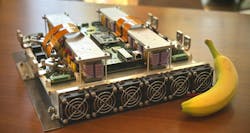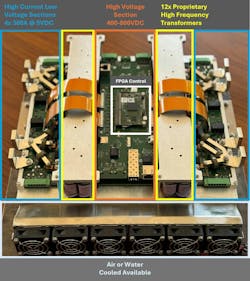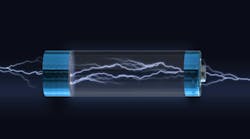Advanced Lithium-Cell Formation Device Increases EV and Grid Battery Life by 50%
What you’ll learn:
- New techniques in rapid cell formation have emerged for EV batteries.
- How to improve the energy efficiency of EV battery-cell manufacturing
- How technologies used in EV charging may benefit the manufacturing process by lowering cost and increasing throughput.
- Rapid cell formation can increase lithium battery life by 50% for applications including electric-vehicle and grid storage applications.
Producing the millions of lithium battery cells to pace the explosive growth of transportation electrification, and enabling renewables to deliver 24/7 energy to the grid that will look to completely displace fossil fuels and nuclear electricity generating plants, requires a massive unit-throughput. It also needs tremendous amounts of energy input, from what’s now commonly referred to as a “gigafactory.”
Gigafactories load initial electrical energy into their newly fabricated lithium battery cells with tens to hundreds of thousands of formation channels (or also known as “cell conditioning channels”). They perform the classically slow charging/discharging/resting process to form the electrochemical composition of the cells.
Cell Formation Channels
This slow legacy process of cell formation can typically take several weeks to complete for each cell. To solve this runtime problem, cells are formed in huge parallel “channels” of formation units.
What if the time to form cells, and the energy consumption to do so, could be significantly reduced? Three key advances in battery-cell formation methodologies are changing the game of formation to address those issues:
1. Increasing the Speed of the Charging and Discharging Process
Typically, the initial charge cycle of a newly manufactured cell is done slowly at a very low C-rate1 (i.e., c/10 or c/20) to prevent lithium plating.
To speed things up, higher C-rates (for example, 2 or 3C) were historically attempted, which would allow the cell formation cycles to happen much faster. While significant resting times between charge/discharge cycles are still required, fast formation could reduce the charge/discharge steps from 20-30 hours to less than one hour.
With fast formation, though, lithium consumption, or “plating,” was considered to be an adverse side effect. But a recent study by SLAC (see Electronic Design’s article “Minor Change Boosts Electric-Vehicle and Grid Battery Lifetime by 50%”) now shows that the “adverse side effect” causing lithium consumption due to fast formation, which was rejected as bad practice, has a significant impact on the lifetime of the cell: An average of 50% increase in life expectancy is achievable for lithium batteries in applications that include electric vehicles and grid storage.
Such a huge increase in lifetime impacts both the first life of an EV’s cell, as well as the extended second life in an energy storage system (ESS) after it’s “done” in an EV, as the result of a shallower degradation curve. magine the economic, environmental, and rate of adoption of an EV with first life of 18-22 years, versus the typical 12-15 years of 20% degradation seen now, and then a second life of another 20-30 years with the very same cells doing grid duty. With fast formation, lithium batteries will be useful for up to 50 years before needing to be recycled.
The higher charge/discharge currents not only have the potential to increase the life of the battery, but the higher C-rates could also substantially INCREASE the productivity of the gigafactory. Producing millions of cells each year still requires significant numbers of parallel processes and channels. However, the 30X throughput in time due to fast charging means either fewer processes and channels, or a major boost in capacity.
2. Reduce Resting Time in the Formation Cycle
The next big technology challenge is to reduce the resting process of the cells. This is typically performed over a period of days, while the chemical reactions occur inside the cells until the cells “stabilize.”
Many companies have been investigating the use “pulse charging” during the life of the battery in applications such as an EV. This involves a process that uses a protocol of charge and discharge current pulses during the charging of the EV instead of a continuous constant current to, supposedly, help with the life of the battery. The pulses are thought to facilitate better lithium-ion distribution in the anode sub-structure during the charging process, which rejuvenates the battery.
An example would be a 10-ms charge pulse of 200 A into the EV battery, followed by a 5-ms discharge pulse of 50 A, and then with a 5-ms rest, the cycle repeats. While this still has a significant net accumulated charge into the battery, the amount of energy delivered to the battery during the same time period is less than half of a constant 200-A charge.
Such cyclic current delivery is seen as something that could be done as a “maintenance charge.” But the results on the life of the battery seem to be very positive (no pun intended).
Why is this important for cell formation? With the maintenance charge demonstrating that cells can be charged with high pulse currents, what if some of these same concepts were applied to the cell formation process? And with the speed of charging enhancements achieved with rapid formation charging/discharging, can some of those time savings be given up to accommodate the channels for pulse formation?
Some preliminary research seems to show that formation pulse charging can help speed up the relaxation of the cells during the formation process. This leads to significantly reduced the rest periods in the cell formation process. Reducing 40% to 50% of the rest time in conjunction with the rapid formation process could considerably cut the time for the formation process down. These enhancements were applied to the process to reduce manufacturing time, but what about the needed energy?
3. Battery Energy Recycling
This is where regenerative cell formation channels come into play. Channels can be used “back-to-back,” whereby the channels can be sequenced to have half the channels charge while the other half discharge so that the discharged energy of one cell is used by the charging cycle of another, circulating the energy and “reusing” it repeatedly. This reduces the overall factory “wallplug” power requirement of the charging/discharging process to only that needed to augment the power losses.
“Typical” low-cost cell formation channels are in the <90% efficiency range for charging, with many being non-regenerative (i.e., 0% efficient in terms of factory wallplug efficiency) for discharging. By using formation channels that are regenerative and maintain higher efficiencies on the order of 93% to 95% or better, operating costs shrink substantially, with:
- Lower heat generation: All of the energy lost in efficiency is heat that’s transferred to the manufacturing facility. With most gigafactories being sited in rural, warmer areas, additional energy is needed to cool the facility, where the cooling system itself also has losses.
- Smaller utility grid connection requirements: Beyond being able to “recycle” the charge/discharge energy, by having a more efficient power channel, the needed grid connections to, and in, the facility can be reduced. This also lowers costs for the power distribution inside the facility to bring power from the main power panels to the formation equipment.
- Decreased TCO: The higher efficiency means that the power needed to run the formation equipment 24/7/365 is lower.
To enable these technology breakthroughs, Unico LLC, a Wisconsin, USA-based technology company, launched a novel battery formation power platform, the BAT350 (Fig. 1). It can deliver the high currents needed for rapid formation, the speed required for the fast pulse formation techniques, and the regenerative power topology and high efficiency to save energy—at a price similar to traditional formation channels.
By utilizing the power of FPGA control, the speed of silicon-carbide (SiC) MOSFETs, and proprietary and innovative, ultra-efficient, and low-inductance high-frequency transformers, the novel flyback transformer design is achieving these performance targets with high efficiency and low cost.
Figure 2 depicts the functional partitioning of the BAT350. The devices are ready to be built into any battery formation system lines, new or existing, to utilize these breakthroughs in battery cell formation. This will revolutionize the operational life of lithium batteries in electric-vehicle and grid storage applications by disrupting acquisition and operational economics, and bolstering owner confidence.
Editor’s note: Visit Unico’s booth #1804 to see the BAT350 High Current Formation Channels unit at The Battery Show in Detroit, Michigan from Oct 7-10. Also, check out Power & Motion's, our sister publication, article for more details on the show, which includes a product gallery highlighting some of the top advances on display.
Reference
1. C-rate is the rate at which current, which correlates to energy, is added to the cell. 1C is the charge (or discharge) rate that takes the cell from 0% to 100% (or 100% to 0%) SOC, or State-Of-Charge, in 1 hour (ignoring the necessary throttling of current near 90-100% SOC to prevent over charging)
Download the Sept/Oct “Makers” issue of Electronic Design, which covers all aspects of Making, from making inexpensive custom semiconductor ASICs, through converting an ICE vehicle to electric propulsion.
Andy Turudic’s Nonlinearities blog arrives the first and third Monday of every month. To make sure you don't miss the latest edition, new articles, or breaking news coverage, please subscribe to our Electronic Design Today newsletter.
About the Author

Donald Wright
VP of Engineering, Unico LLC
Donald Wright has been in the automotive testing industry for more than 30 years with close to 20 focused on EV testing, including battery (cell, module, pack), inverter, e-motor/e-axle. He is the VP of Engineering at Unico LLC, where the company uses its power electronic “drive” products to test and control “spinning things” and “non-spinning things.”




